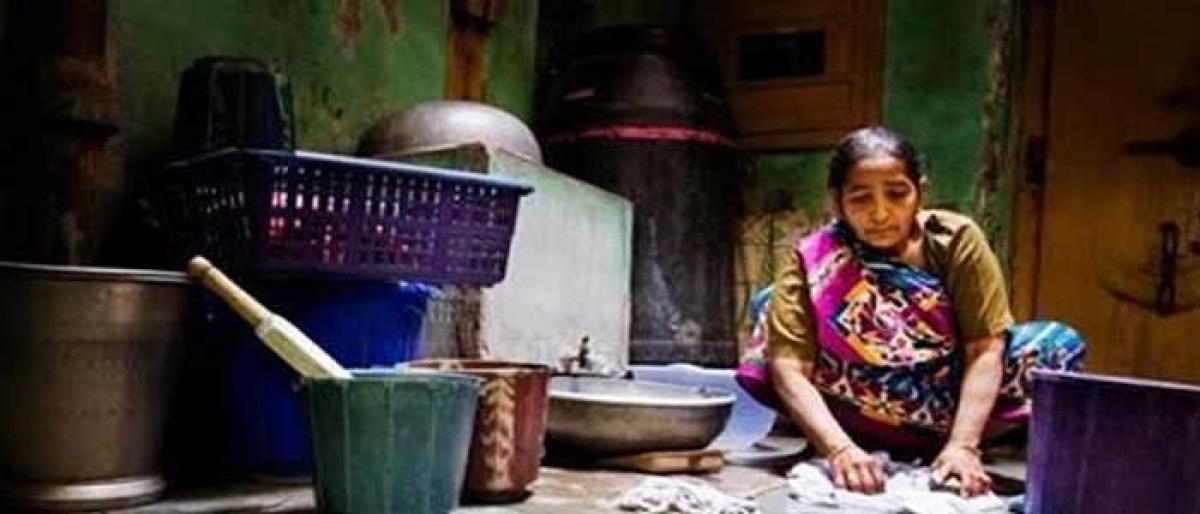Challenges associated with domestic workers in India

The recent case of a minor girl in Noida being accused of stealing; and the counter allegations of her ill-treatment are the latest in a long list of incidents involving domestic workers and questions of the rights of such workers.
The recent case of a minor girl in Noida being accused of stealing; and the counter allegations of her ill-treatment are the latest in a long list of incidents involving domestic workers and questions of the rights of such workers.
A clash on 12 July between domestic workers and their employers in an upmarket, gated housing society in Noida has snowballed into a full-blown class war with an overt anti-Muslim dimension.
- Domestic worker is a person who is employed in any household on a temporary or permanent basis to do the household work.
- In the decade after liberalisation, there was a nearly 120% rise in the number of domestic workers in India.
- Women constitute over two-thirds of the workforce in this unorganised sector.
- According to estimates by the International Labour Organisation (ILO), there are at least four million domestic servants in India.
- Domestic work as an economic activity is too vast and employs too many to remain unregulated. Though the 2011 NSSO data put the number of domestic workers at 3.9 million, trade unions estimate the number to be around 10 million.
- Most of these are from vulnerable communities – Adivasis, Dalits or landless OBCs. Nearly all of them are migrant workers. And an overwhelming number are women.
Present Status
- Most of these are from vulnerable communities – Adivasis, Dalits or landless OBCs.
- Most of them are migrant workers and an overwhelming number are women.
- Many resort to domestic work because of decline of employment opportunities in the agriculture and manufacturing sectors.
- The work has no reputation and generally considered as a menial work in exchange of some amount.
Domestic workers are comprised of three main groups
- Live-in domestic workers
- Part-time / Live-out domestic worker
- Migrant Domestic Workers
- Inter-state domestic workers
- Overseas domestic workers
Live-in domestic workers
- Live-in domestic workers reside at the place of employment.
- They are engaged in all domestic work ranging from housekeeping, washing clothes, utensils, cooking and even engaged in baby, children or elderly care.
- They depend on their employers for basic needs such as food and shelter.
- Most livein domestic workers are women who have migrated or have been trafficked from villages to cities in search of employment.
- They are to large extent children, unmarried and sometimes married young girls, separated or widowed women.
Part-time domestic workers
- Part-time domestic workers are generally locals or migrants in the city where they are employed. They mostly live in slums and work in the houses of multiple employers to earn their livelihood.
- They are called part-timers not because they do only part time work but because they do not stay with the employer and are not expected to be on call 24 hours a day.
- They either work all day for one employer or repeatedly perform specific tasks like washing clothes, dishes, or cooking for a number of employers.
- Part-timers are less dependent on their employers than full time workers.
- They live with their families and run their homes, as well as those of their employers.
- However, they are less dependent on their employers for their basic needs and are characterized with a greater degree of independence than the live-in domestic workers.
Migrant domestic workers
- Many women migrate from their villages to work as domestic workers. This migration takes two forms:
- Inter-state Domestic Workers
- Overseas Domestic Workers
Overseas Domestic Workers
- Whether the domestic worker remains in India or travels to the Middle East or Southeast Asia, she finds herself in a foreign environment, away from her family and adjusting to new languages, food, and cultures.
- Migrants are typically live-in domestic workers and are thus most vulnerable to physical and sexual abuse, excessively long working hours, and deprivation.
- Many of them are from tribal regions and the traditional discrimination they face as women and as live in domestic workers is compounded by their ethnicity.
- Despite these problems, poor women are forced to migrate to cities and foreign countries in order to supplement their families’ meager incomes.
Migration within India
- Migration from rural areas to big cities typically occurs due to debt bondage, poverty, sudden death in the family, rural and male unemployment.
- The glamour of city life acts as a further “pull” factor inducing young girls and women to migrate.
- Working in cities is seen as a solution to poverty and villagers are unaware of the exploitative working conditions and poor remuneration that the vast majority of domestic workers have to endure.
- Additionally, a large number of domestic workers come from areas, which have been subjected to natural disasters and man-made crisis situations (such as insurgency) and as such are from displaced communities.
- Increasingly, “trafficking agencies” have become a very significant factor in encouraging internal migration. In the arena of domestic work, organised trafficking is taking place as villagers living in the cities are returning to their native places to bring more women, girls and children into this labour sector.
- Once the girls arrive in the cities, their wages are typically locked or they go unpaid in order to pay the traffickers a fee for securing employment.
Migration outside of India
- There is an increased demand from richer industrialized countries for cheap, menial and domestic labour.
- Migrants from poorer, less developed countries such as India can jump to this opportunity as it does not require any high skills or education.
- Thousands of Indian women travel to countries in the Middle East, South East Asia, and sometimes Europe and North America in search of jobs paying higher wages.
- However, these women earn the lowest salary for a foreign worker, despite the fact that they may be earning more than they would in India for the same job.
- Many women travel abroad to send money back home in an effort to improve their quality of life in India.
- However, in travelling abroad, they become vulnerable to corrupt recruitment practices, lack of work contracts, withheld salaries, physical, sexual, and emotional abuse at the workplace and in many cases, their travel documents are witheld and they are prevented from returning home.
- In India, the procedure for migrating abroad for work is unregulated.
- The Indian government has not implemented a pre-migration program aimed at educating migrants of their rights.
- In order to travel abroad, migrants are forced to borrow large sums of money, often with exorbitant interest rates, to pay fees to brokers.
- In many cases, the migrants, who are often illiterate and naïve to the potential risks of entrusting large sums of money with strangers, are the victims of scams of the fly-by-night brokers.
- These con artists do not secure the promised job abroad, give them false tickets, or do not secure the appropriate paperwork so that the women can legally work as domestic workers.
- Thus, many women find themselves in a foreign country without the necessary papers.
- They are especially vulnerable to not being paid the promised salary and being held in conditions of slavery without the ability to complain to the police.
- In many cases, the employer holds on to the domestic worker’s passport, preventing her from leaving or contacting the Indian embassy to file complaints.
Issues:
- Most of the domestic servants are migrants, women, many are minors, and belong to the lowest end of the economic spectrum. This makes them easy to replace, and easier still to exploit.
- Indeed, hardly a week goes by without some news report about a domestic help being abused by her employer. Cases of torture, beatings, sexual assault, and incarceration are common.
- Since they belong to the unorganized sector, there are no laws safeguarding their rights – no minimum wage requirements, no health or insurance benefits, and no job security whatsoever.
- The nexus of the state and the market has managed to keep domestic work outside the realm of economic regulation.
- Neither the Maternity Benefits Act nor the Minimum Wages Act or any of the scores of other labour laws apply to domestic work.
- Domestic workers can be hired and fired at will. The employer has no legally binding obligations.
- In a country where 93% of the workforce is in the unorganised sector and therefore beyond the purview of most labour laws, domestic workers represent a new low in terms of disempowerment: they are not even recognised as workers. Their work — cooking, cleaning, dish-washing, baby-sitting — is not recognised as work by the state.
- Apart from facing routine, structural exploitation in the form of low wages, heavy workloads, and long hours, domestic workers face graver dangers, as is evident from cases of employers confining and assaulting them coming to light with frightening regularity.
- The inequality of domestic workers’ circumstances is accentuated by the fact their workplace falls within the privacy of the homes of people that are invariably more privileged than they are.
- Although successive governments have drafted policies, they are yet to become law.
Concerns associated with domestic workers in India:
1. There are around 3.9 million domestic workers in India, according to 2011 NSSO data. However, according to trade unions estimate, there are around 10 million domestic workers in India. Most of these are from vulnerable communities – Adivasis, Dalits or landless OBCs. Nearly all of them are migrant workers. And an overwhelming number are women. But there exists not one law that specifically deals with this unorganized sector, of which women constitute over two-thirds of the workforce in this unorganised sector.
2. Neither the Maternity Benefits Act nor the Minimum Wages Act or any of the scores of other labour laws apply to domestic work. Domestic workers can be hired and fired at will. The employer has no legally binding obligations.
3. Most of the domestic workers are barely of legal working age and their wages less than the minimum fixed by the government.
4. Only a few states like Rajasthan, Andhra Pradesh, Karnataka, Kerala and Bihar have fixed minimum wages, but in most cases the wage rate is fixed arbitrarily, is too low and irrelevant to those working in urban areas where the cost of living is much higher.
5. In a country where 93% of the workforce is in the unorganised sector and therefore beyond the purview of most labour laws, domestic workers represent a new low in terms of disempowerment: they are not even recognised as workers. Their work — cooking, cleaning, dish-washing, baby-sitting — is not recognised as work by the state. (Lack of recognition)
6. Their employers range from Indias elite to its nouveau riche, many of who still believe in the traditional divide between servants and masters. Abuse, mental, physical or sexual, of these women is not uncommon.
7. Cases of torture, beatings, sexual assault, and incarceration are common. Indeed, hardly a week goes by without some news report about a domestic help being abused by her employer.
Challenges
- Their work — cooking, cleaning, dish-washing, baby-sitting — is not recognised as work by the state.
- Domestic work as an economic activity is too vast and employs too many to remain unregulated.
- Neither the Maternity Benefits Act nor the Minimum Wages Act or any other labour laws apply to domestic work.
- Domestic workers can be hired and fired at will. The employer has no legally binding obligations.
- Organising domestic workers has been a huge challenge as the work place is inaccessible and multiple
- As a result, the demand for the better wages or working conditions through an organized union has been weak
- India is a signatory to the ILO’s 189th convention, known as the Convention on Domestic Workers; but has not ratified it yet.
- Little progress has been made in passing Domestic Workers Welfare and Social Security Act, 2010’ Bill.
The ILO Convention on domestic workers
- India is a signatory to the ILO’s 189th convention, known as the Convention on Domestic Workers; but has not ratified it yet.
- The convention mandates that domestic workers be given daily and weekly rest hours, their payment must meet the minimum wage requirement, and that they should be allowed to choose the place where they live and spend their leave.
- Ratifying states are also required to take protective measures against violence against such workers and are required to enforce a minimum age for employment.
- However, since these provisions are not binding on those countries that have not ratified the convention, India is not obliged to enforce these recommendations.
Regulatory framework
- India has only two laws that, in a roundabout way, construe domestic helps as workers. The Unorganised Workers’ Social Security Act, 2008, (UWSSA) and the Sexual Harassment of Women at Workplace (Prevention, Prohibition and Redressal) Act, 2013. While the former is a social welfare scheme, the latter is aims to protect working women in general. Neither of these recognizes domestic helps as rights-bearing workers.
- About half the states have included domestic workers as labourers under the Minimum Wages Act, which sets out terms of payment, hours of work and leave. Yet, this law is grossly inadequate. The law does not, for instance, require domestic workers and employers to register with any authority, which is crucial for monitoring whether both parties are fulfilling their contractual obligations and for adjudicating conflicts.
- Some states, such as Kerala and Tamil Nadu, do have welfare boards for domestic workers that attempt to do this, but they have meagre funds and do not go far enough. A national law should also regulate the numerous for-profit domestic workers’ agencies that have sprung up, some of which are suspected of putting children to work.
- Thus far, there is no national law that governs domestic employment.
‘Domestic Workers Welfare and Social Security Act, 2010’ Bill:
- Drafted by the National Commission for Women (NCW).
- It attempted to bring this large and vulnerable work force into the mainstream. But little progress has been made in passing this bill so far.
The Domestic Workers Regulation of Work and Social Security Bill, 2016:
Drafted by the National Platform for Domestic Workers.
- Going beyond state-centric welfare measures, it calls for the compulsory registration of the employer and the employee with the District Board for regulation of domestic workers.
- Unlike the UWSSA, which puts the onus on the state, it mandates the collection of cess from the employer for the maintenance of a social security fund for domestic workers, whose access would be mediated through an identity card.
- This framework achieves both the objectives of police verification — security, and documentation of identification data.
- It provides for basic terms of employment like a minimum wage, hours of work, notice period and grounds for termination, as well as offences and penalties in the case of crimes.
Draft National Policy for domestic workers
- This policy not only calls for promoting awareness of domestic work as a “legitimate labour market activity”, but also recommends amending existing labour laws to ensure that domestic workers enjoy all the labour rights that other workers do.
Laws for domestic workers
- India has only two laws. The Unorganised Workers’ Social Security Act, 2008, (UWSSA) and the Sexual Harassment of Women at Workplace (Prevention, Prohibition and Redressal) Act, 2013.
- Neither of these recognises domestic helps as rights-bearing workers.
- The draft National Policy for Domestic Workers calls for promoting awareness of domestic work as a legitimate labour market activity.
Background of legislations associated with domestic workers:
‘Domestic Workers Welfare and Social Security Act’
- In 2010, the National Commission for Women had drafted the ‘Domestic Workers Welfare and Social Security Act’ to help address complaints about unpaid wages, starvation, inhumane work hours and verbal, physical and sexual abuse. The proposed law was meant for domestic workers above 18 years of age and clearly stated that no child shall be employed as a domestic worker. (But the draft remained a proposal.)
- International Labour Organization (ILO’s) Convention 189
- In 2011, the International Labour Organization adopted Convention 189 which “offers specific protection to domestic workers. It lays down the basic rights and principles, and requires States to take a series of measures with a view to making decent work a reality for domestic workers”. (India voted in favour of the convention, but is yet to ratify it.)
- Ratifying an international convention amounts to a formal commitment to implement all the obligations, including passing of comprehensive legislation for domestic workers.
Rashtriya Swasthya Bima Yojana (RSBY)
- The same year (in 2011), the government made a half-hearted effort by including domestic workers in the Rashtriya Swasthya Bima Yojana (RSBY) – a smart card based cashless health insurance scheme. But, there was a catch. Only registered domestic workers could avail the cover of up to Rs 30,000 cover.
- To register, a domestic worker would have to get certificates from two of four listed institutions – the employer, the police, the resident welfare association, or recognised trade unions.
Unorganised Workers Social
- Security Act, 2008 and S--sexual harassment of women at workplace
- India has only two laws that, in a roundabout way, construe domestic helps as workers.
- The Unorganized Workers Social Security Act, 2008 (UWSSA) and the Sexual Harassment of Women at Workplace (Prevention, Prohibition and Redressal) Act, 2013 – include domestic workers, but does not address their specific vulnerabilities.
- While the former is a social welfare scheme, the latter is aims to protect working women in general. Neither of these recognises domestic helps as rights-bearing workers.
Social Security schemes for Domestic workers
- In order to provide social security benefits to the workers in the unorganised sector including domestic workers, the Government has enacted the Unorganised Workers’ Social Security Act, 2008.
- The 2008 Act stipulates formulation of suitable welfare schemes for unorganized workers on matters relating to: (i) life and disability cover,
(ii) health and maternity benefits,
(iii) old age protection and
(iv) any other benefit as may be determined by the Central Government through the National Social Security Board. Various Schemes, formulated by the Government to provide social security cover to the unorganized workers, listed in the Schedule I of the above Act are as under:
1. Indira Gandhi National Old Age Pension Scheme (Ministry of Rural Development)
2. National Family Benefit Scheme (Ministry of Rural Development)
3. Janani Suraksha Yojana (Ministry of Health and Family Welfare.
4. Handloom Weavers’ Comprehensive Welfare Scheme (Ministry of Textiles)
5. Handicraft Artisans’ Comprehensive Welfare Scheme (Ministry of Textiles)
6. Pension to Master Craft Persons (Ministry of Textiles)
7. National Scheme for Welfare of Fishermen and Training and Extension (Department of Animal Husbandry, Dairying & Fisheries
8. Aam Admi Bima Yojana (Department of Financial Services.
9. Rashtriya Swasthya Bima Yojana (Ministry of Health and Family Welfare)
- Central Government has also launched the Atal Pension Yojana, Pradhan Mantri Jeevan Jyoti Bima Yojana and Pradhan Mantri Suraksha Bima Yojana for all citizens especially targeting unorganised workers to provide them comprehensive social security.
Way forward:
- To view domestic workers as a security threat is another way of denying them the status of workers. The policy mindset regarding domestic workers must shift from a law-and-order paradigm to one about workers’ rights.
- A good place to start would be to consider enacting a Domestic Workers Regulation of Work and Social Security Act. Such a law will, above all, recognise domestic work as labour, partly addressing society’s devaluation of housework. A national law also needs to oversee workers’ safety, provide for health emergencies and their children’s education, among other things.
- Some have attempted to justify the government’s reluctance to regulate domestic work on the grounds that the workplace is a private household which should not be encroached upon by the state. But this argument does not hold since the anti-sexual harassment law recognizes the private household as a workplace.
- The ongoing conflict also suggests that laws can serve only as enabling frameworks, albeit crucial ones, for improving these employees’ abysmal working conditions and terms. To be able to use the law effectively, domestic workers also need to organize, given that their employers are in an economically and socially superior position.
Conclusion:
Estimates of the number of domestic workers in the country vary from 3.9 to 10 million. No liberal society, or modern economy, can allow such a large number to remain outside the law as “help”. It is perhaps past time that India revived debate on the Domestic Workers Security bill.

















